Lifestyle
Politics aside, EVs will be — must be — the future of transportation
President-elect Donald Trump hardly professed to be a friend of clean renewable energy during his campaign, that’s for sure. The forces of change toward a sustainable energy future for the U.S. and world, however, are so powerful and dynamic that a Trump presidency may not be able to stop them. The momentum inspired by Tesla’s Elon Musk, MIT’s Electric Vehicle Team, the Google Self-Driving Car Project, Panasonic batteries, “Last Mile” transportation, The Route electric refuse trucks, and so many other electric vehicles is too strong and too ingrained in our culture to be stymied now.
As Rebecca Solnit wrote in her classic book, Hope in the Dark, “You possess the power to change the world to some degree, the current state of affairs is not inevitable, and all trajectories are not downhill.” With activism and advocacy, as well as technological innovations that emerge regardless of political times, clean renewable energy sources will continue to expand. They must, for the sake of our planet.
For example, some things just have not changed in Americans’ relationships to their cars. Over the past 50 years, automobiles have been our freedom machines, a means of both transportation and personal identity expression. In the same way that Henry Ford matched a youthful and euphoric generation to the combustion-engine automobile, so, too, will tomorrow’s automakers continue to design strategic moves to shape the industry’s evolution.
Electric vehicles (EVs) are at the heart of that vision for tomorrow’s consumer domestic transportation. Here are some reasons why EVs will continue to flourish and change the way automakers in the U.S. and abroad have conducted business as usual.
Automakers will continue to know what the customer wants and provide it
Consumer acceptance has already established a formidable EV market. EVs include a large portion of hybrid electrics, which means that, even beyond 2030, the internal-combustion engine will remain — at least partially — relevant. Yet we’ll likely encounter a common culture of electrified vehicles –hybrid, plug-in, battery electric, and fuel cell — in the years to come. But only an iconoclastic automaker will offer consumers a combustion engine without the electric perks.
Consumers just want to be connected
The capacity to be able to consume novel forms of media and other technology applications while driving will only become more prevalent among commuters. This will be possible, in part, through enhanced levels of automotive software competence. It’s an immediate gratification world already, and, with the emergence of new forms of infotainment technologies and virtual realities, consumers are only going to yearn for more connectivity. Traditional automakers will give their customers what they want in connectivity, inching every so much closer to comprehensive EV technologies.
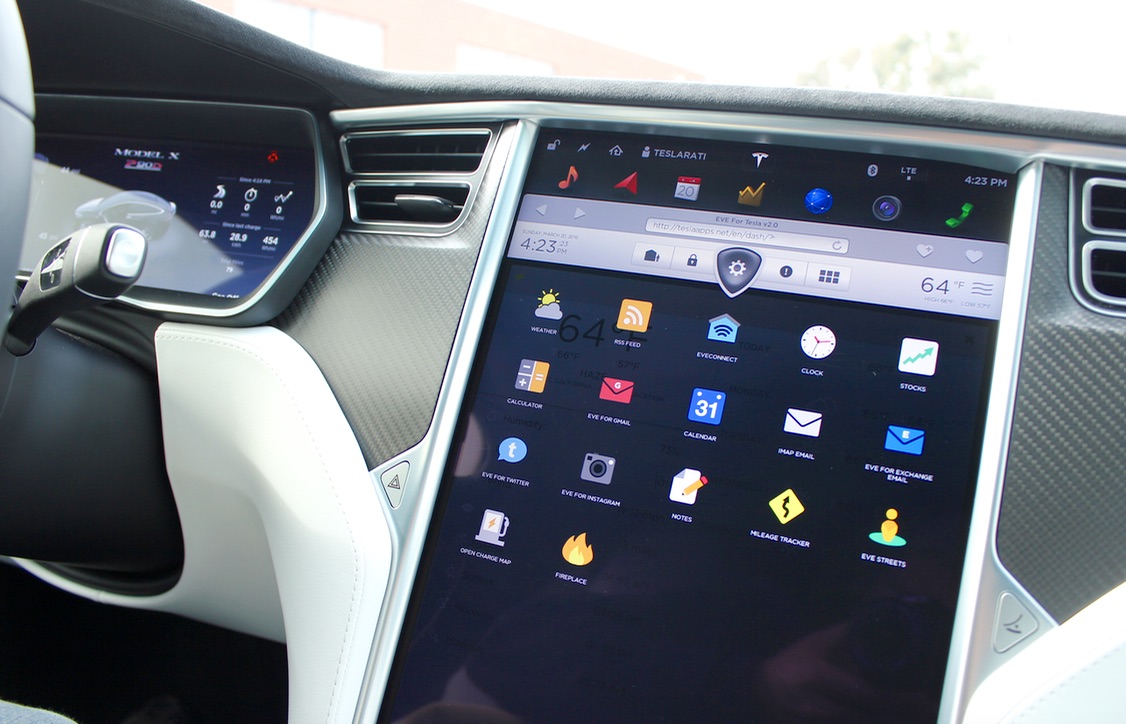
Suite of “apps” found within EVE for Tesla
Improvements in battery technology and costs
Through continuous improvements in battery technology and cost, electrified vehicles will become more “normal” and more likely to be found in the average American’s garage. As a result, EVs will increasingly grab market share from conventional vehicles. With battery costs potentially decreasing by $150 to $200 per kilowatt-hour over the next decade, electrified vehicles will be able to compete more heartily and broadly with conventional vehicles. Automakers will migrate to this new battery technology because it will make obvious financial sense.
A more widely available charging infrastructure
Increasingly, many retailers are seeing the benefit of customers who browse inventories deeply and purchase more intensely as they wait for their EVs to charge outside in the parking lot. This collaboration between EV drivers and retailers will certainly expand the demand for and number of corridor-based charging stations. Shopping centers, entertainment stops, and EV charging may require charging station standardization, of course, for the gestalt to be fully pervasive. That will take consensus-building with other charging station manufacturers.
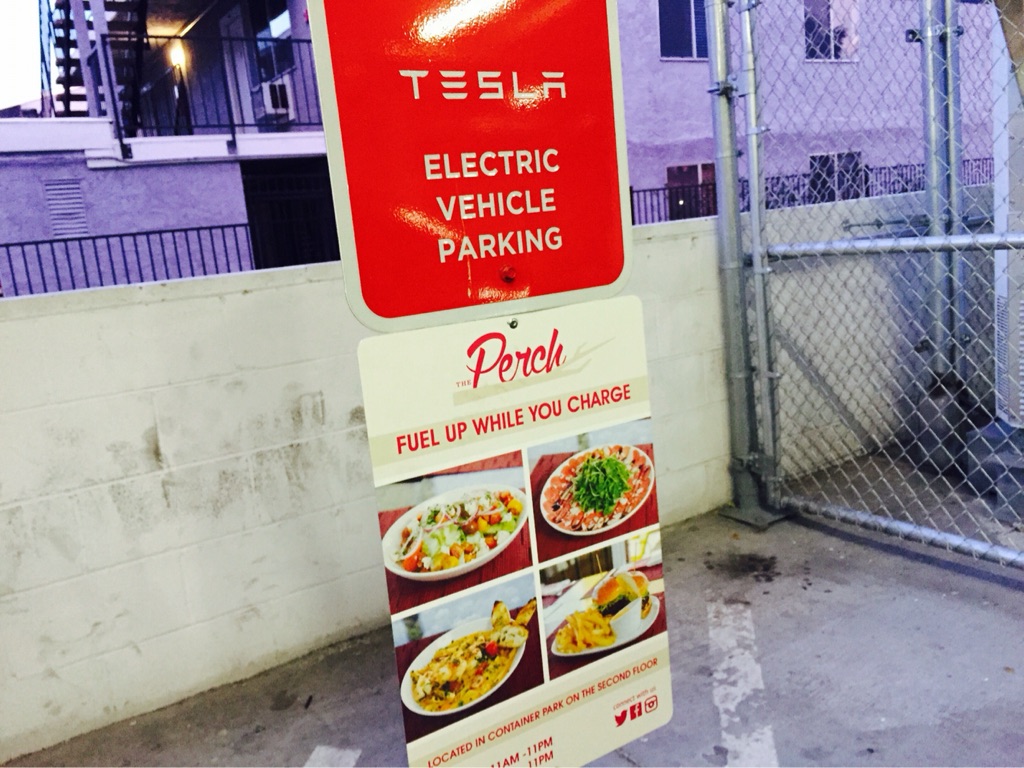
A local restaurant advertising to Tesla owners at the Las Vegas Supercharger.
Autonomous technology
Advanced driver assistance systems (ADAS), with their associated active safety precautions, will quickly allow the automobile to become a platform for drivers and passengers to choose how to use their transit time. EVs and ADAS are so interwoven already that the future must continue those marriages. Yes, there’s still lots of progress that needs to be done around technological and regulatory issues fronts, but is it excessive to think that around 15 percent of new cars sold in 2030 could be fully autonomous? Not really.
Diverse mobility solutions are coming
Traditional business models of car sales will be complemented by a range of diverse, on-demand mobility options. These are sometimes called “last mile” solutions and are particularly necessary in dense urban environments that limit private car entrance. Think central London. EVs are certain to be integral to the trend to increase and diversify on-demand mobility and data-driven services.
Stricter emission regulations
We’re not really sure that a Trump presidency will speed federal regulations toward greater fuel efficiency, if some comments he made on the campaign trail can actually find their way into governance. But, if the U.S. holds to its pledges to further the goals of the Paris Climate Conference (also known as COP21), automakers will scramble to balance out their catalogs. Their gas guzzling behemoths in the full-sized truck category will need their siblings, fuel-efficient EVs. Traditional automakers may have no other recourse than to adopt an EV line of offerings in order to offset those nasty truck MPGs.
The push for traditional automakers to become more capital efficient
Like any business, traditional automakers are under constant pressure from stockholders, who want to see lower overheads, improved fuel efficiency, and reduced emissions. Even if incentives toward purchases of EVs expire, stockholder influences may propel a shift of automaker perspectives, based on little more than the bottom line. This push toward greater capital efficiency will necessarily lead to new business relationships between automakers and technologists.
Competition from abroad
Always on the (pun intended) horizon is the looming threat of other countries and their automotive innovations. It seems unlikely that a Trump administration can foster the political power to exclude car imports, and, anyways, U.S. automakers would like nothing more than to transform their models for the global marketplace. For example, China’s emergence as the world’s largest automotive market can only expand in the coming years and, with that need to supply an enormous consumer base, will be trends toward EVs. U.S. automakers may find themselves outside the marketplace if they don’t keep up with their counterparts abroad.
Conclusion
A white paper titled “Automotive revolution — Perspective toward 2030” describes how the coming generations should see the share of electrified vehicles range from 10 percent to 50 percent of new-vehicle sales. Adoption rates will be highest in developed dense cities with strict emission regulations and consumer incentives. These include tax breaks, special parking and driving privileges, or discounted electricity pricing. Sales may be less robust in small towns and rural areas with lower levels of charging infrastructure and higher dependency on driving range.
As Hillary Clinton said in her concession speech, “Never stop believing that fighting for what’s right is worth it.” Changing consumer preferences, tightening regulation, and technological breakthroughs, among myriad other factors, point to the dominance of EVs in the decades to come. We’ve got to use this moment in political time to rise up and speak out for the future of electric vehicles.

Lifestyle
Tesla Model S Plaid battles China’s 1500 hp monster Nurburgring monster, with surprising results
There is just something about Tesla’s tuning and refinement that makes raw specs seem not as game-changing.
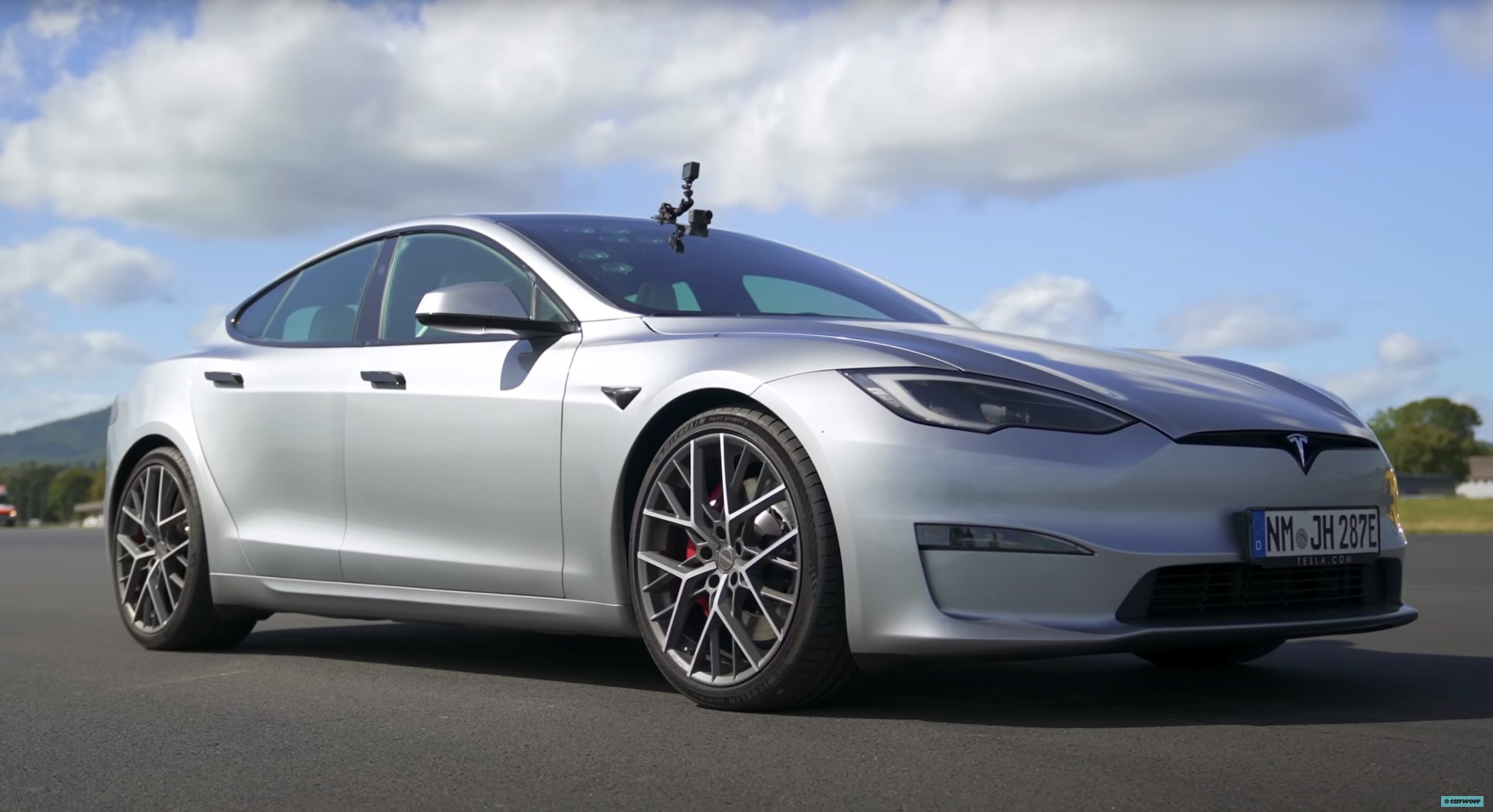
The Tesla Model S Plaid has been around for some time. Today, it is no longer the world’s quickest four-door electric sedan, nor is it the most powerful. As per a recent video from motoring YouTube channel Carwow, however, it seems like the Model S Plaid is still more than a match for some of its newer and more powerful rivals.
The monster from China
The Xiaomi SU7 Ultra is nothing short of a monster. Just like the Model S Plaid, it features three motors. It also has 1,548 hp and 1,770 Nm of torque. It’s All Wheel Drive and weighs a hefty 2,360 kg. The vehicle, which costs just about the equivalent of £55,000, has been recorded setting an insane 7:04.957 at the Nurburgring, surpassing the previous record held by the Porsche Taycan Turbo GT.
For all intents and purposes, the Model S Plaid looked outgunned in Carwow’s test. The Model S Plaid is no slouch with its three motors that produce 1,020 hp and 1,420 Nm of torque. It’s also a bit lighter at 2,190 kg despite its larger size. However, as the Carwow host pointed out, the Model S Plaid holds a 7:25.231 record in the Nurburgring. Compared to the Xiaomi SU7 Ultra’s record, the Model S Plaid’s lap time is notably slower.
Real-world tests
As could be seen in Carwow’s drag races, however, Tesla’s tech wizardry with the Model S Plaid is still hard to beat. The two vehicles competed in nine races, and the older Model S Plaid actually beat its newer, more powerful counterpart from China several times. At one point in the race, the Xiaomi SU7 Ultra hit its power limit due to its battery’s temperature, but the Model S Plaid was still going strong.
The Model S Plaid was first teased five years ago, in September 2020 during Tesla’s Battery Day. Since then, cars like the Lucid Air Sapphire and the Xiaomi SU7 Ultra have been released, surpassing its specs. But just like the Model Y ended up being the better all-rounder compared to the BYD Sealion 7 and the MG IM6, there is just something about Tesla’s tuning and refinement that makes raw specs seem not as game-changing.
Check out Carwow’s Model S Plaid vs Xiaomi SU7 drag race video below.
Lifestyle
500-mile test proves why Tesla Model Y still humiliates rivals in Europe
On paper, the BYD Sealion 7 and MG IM6 promised standout capabilities against the Model Y.
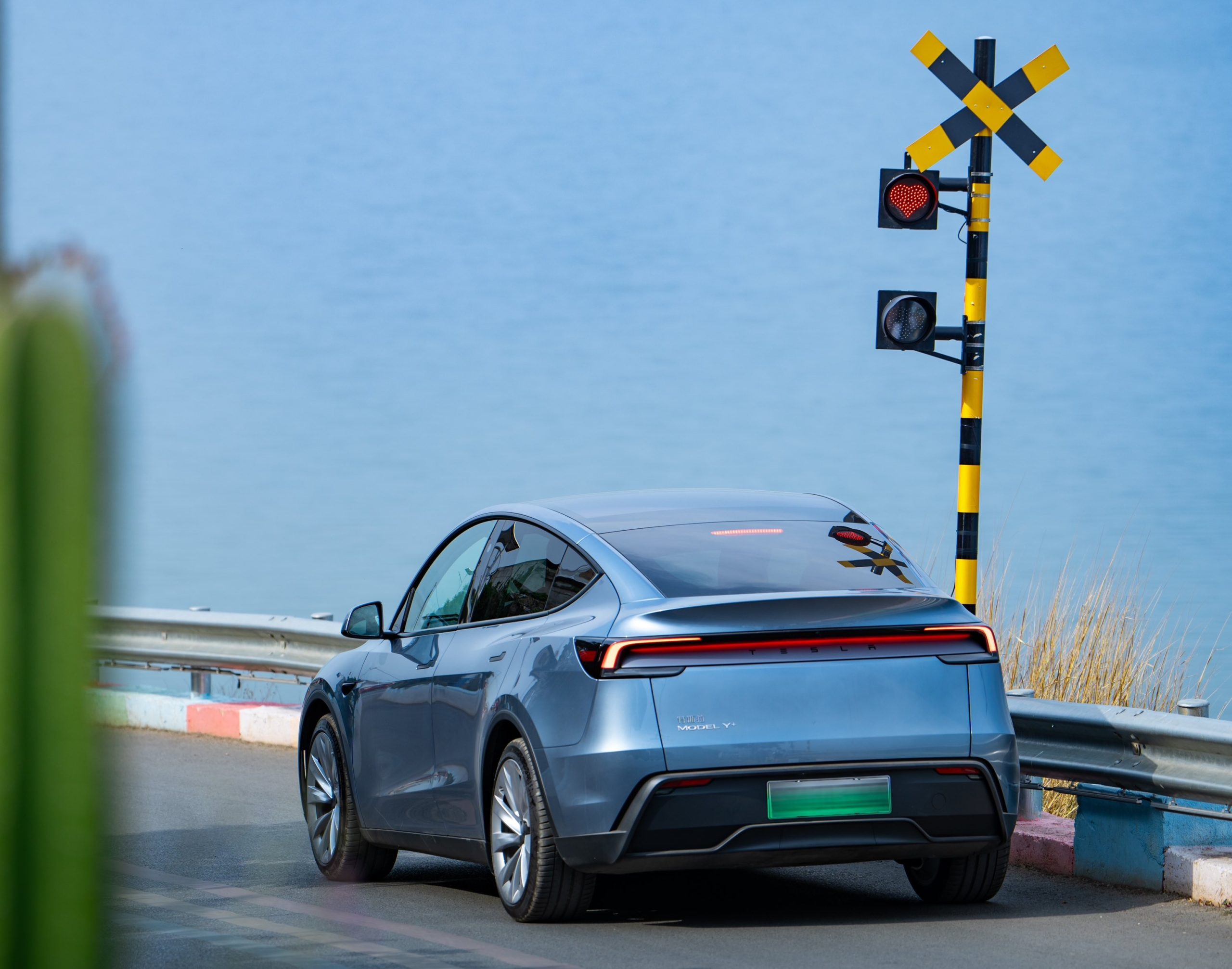
BYD is seeing a lot of momentum in Europe, so much so that mainstream media has taken every opportunity to argue that the Chinese automaker has beaten Tesla in the region. But while BYD sales this year in Europe are rising and Tesla’s registrations remain challenged, the raw capabilities of vehicles like the Model Y are difficult to deny.
This was highlighted in a 500-mile challenge by What Car? magazine, which showed that the new Tesla Model Y is more efficient, cheaper to run, and more reliable than rivals like the BYD Sealion 7, and even the nearly 400 KW-charging MG IM6.
Range and charging promises
On paper, the BYD Sealion 7 and MG IM6 promised standout capabilities against the Model Y. The Sealion 7 had more estimated range and the IM6 promised significantly faster charging. When faced with real-world conditions, however, it was still the Model Y that proved superior.
During the 500-mile test, the BYD nearly failed to reach a charging stop, arriving with less range than its display projected, as noted in a CarUp report. MG fared better, but its charging speeds never reached its promised nearly-400 kW charging speed. Tesla’s Model Y, by comparison, managed energy calculations precisely and arrived at each stop without issue.
Tesla leads in areas that matter
Charging times from 25% to 80% showed that the MG was the fastest at 17 minutes, while Tesla and BYD were close at 28 and 29 minutes, respectively. Overall efficiency and cost told a different story, however. The Model Y consumed 19.4 kWh per 100 km, compared to 22.2 for MG and 23.9 for BYD. Over the full trip, Tesla’s charging costs totaled just £82 thanks to its supercharger network, far below BYD’s £130 and MG’s £119.
What Car? Magazine’s testers concluded that despite BYD’s rapid sales growth and the MG IM6’s seriously impressive charging speeds, Tesla remains the more compelling real-world choice. The Model Y just offers stability, efficiency, and a proven charging infrastructure through its Supercharging network. And as per the magazine’s hosts, the Model Y is even the cheapest car to own among the three that were tested.
Watch What Car? Magazine’s 500-mile test in the video below.
Lifestyle
Tesla Cybertruck slapped with world’s least intimidating ticket, and it’s pure cringe
One cannot help but cringe and feel second-hand embarrassment at the idea of a person just driving around with a stack of these babies.
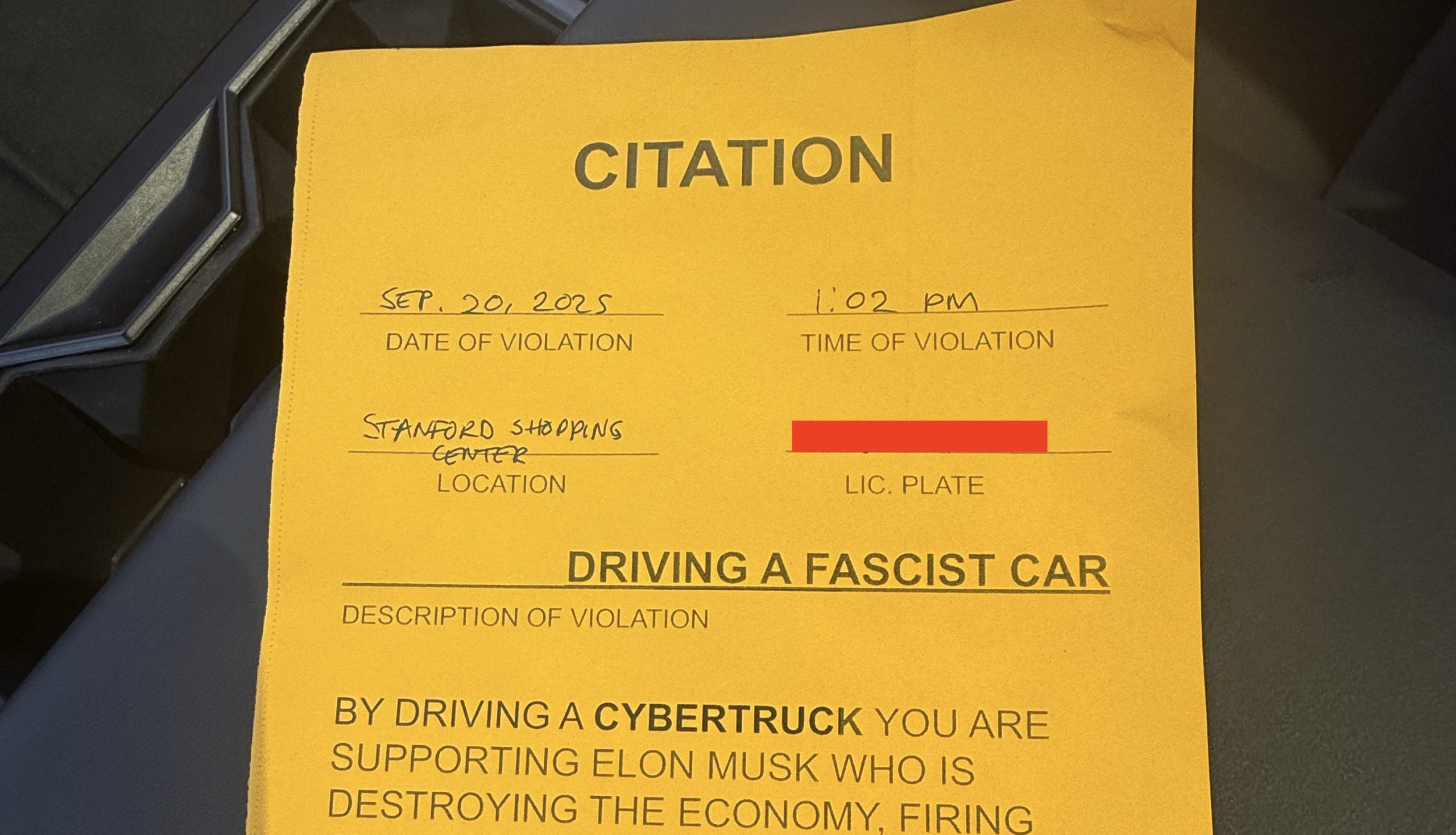
A Cybertruck parked at Stanford Shopping Center in California was recently hit with what might be the most try-hard piece of paper ever slipped under a wiper blade: a “fake citation” accusing the driver of supporting a “fascist car.”
The note, shared on X by Tesla staff program manager Ryan Torres, quickly made the rounds on X, where it quickly gained attention as an example of how not to protest.
The world’s least intimidating ticket
According to the citation, the supposed “violation” was “driving a fascist car.” The remedial action? Take the bus, call an Uber, or ride a bike. The note also dubbed Elon Musk a “chainsaw-wielding Nazi billionaire.” Now, protests against Tesla and Elon Musk have become commonplace this year, but one cannot help but cringe and feel second-hand embarrassment at the idea of a person just driving around with a stack of fake anti-Tesla/Musk citations.
Torres pointed out the irony himself in his post on X. Tesla currently employs over 140,000 Americans, and SpaceX has put the U.S. firmly back at the top of space technology. As Torres put it, maybe the person behind the world’s least intimidating ticket should “read a book on innovation before vandalizing” other people’s property.
Peak performative clownery
Not to mention that the fake ticket’s logic collapses under its own weight. EVs like the Cybertruck are literally designed to reduce emissions, not “destroy the economy.” If anything, Tesla has bolstered the United States’ economy by fueling jobs in engineering, manufacturing, and clean energy. It’s not the first time a Tesla has been the target of vandalism or politically charged notes, but this one stands out for sheer cringe value.
Torres summed it up neatly: “Peak clownery.” On that point, at least, the citation earns full marks. In a way, though, perhaps cringe fake tickets are not as bad as the literal firebombs that were being thrown at Tesla stores and cars earlier this year because some critics were gleefully misinformed about Elon Musk.







